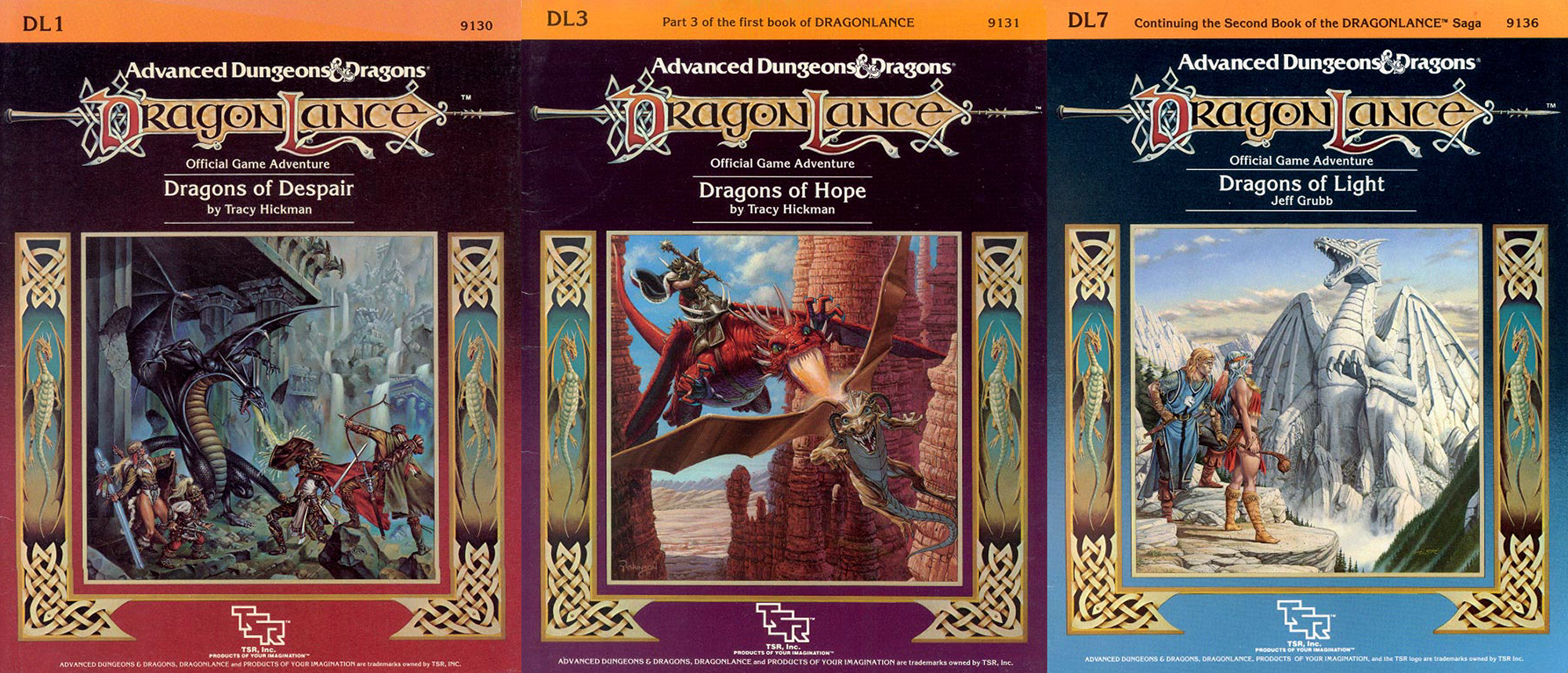
This article is going to make a lot more sense if you’re familiar with:
- the Dragonlance Saga
- Hexcrawls
- Pointcrawls
Dragonlance was created in 1982 by Tracy and Laura Hickman. Tracy and Laura had self-published several D&D modules, which had resulted in Tracy being hired by TSR, Inc. While they were driving from Utah to TSR’s headquarters in Wisconsin, they came up with the idea of an epic series of modules featuring what were, at the time, all twelve types of dragons.
In 1983, TSR’s marketing department identified a common theme in their survey data: Dungeons & Dragons had lots of dungeons, but where were all the dragons? In response, proposals were requested for a dragon-themed project. Two proposals were submitted – one by Tracy Hickman and one by Douglas Niles – and Hickman’s was selected. Under the guidance of Harold Johnson, an all-star team of designers and artists was assembled.
The result was a series of fourteen modules – DL1 through DL14 – consisting of twelve linked adventures, a setting gazetteer (DL5) and a wargame (DL11). These fourteen modules are the original Dragonlance Saga, which gave rise to novels, comics, calendars, miniatures and more.
Hexcrawls are a method of running wilderness adventures. The wilderness is mapped onto a hexmap and content is keyed to each hex. Travel mechanics then determine how the PCs move through the hexmap and when/how they trigger the content keyed to each hex. You can find more information on hexcrawls in the 5E Hexcrawls series.
Pointcrawls are another method of running exploration and travel adventures. A map is prepped with multiple points connected by paths. Content is keyed to each point, and the PCs can maneuver through the pointmap by choosing one of the paths connected to whatever point they’re currently in. Pointcrawls are often used to model wilderness trails, but can have varied applications. We’ve previously discuss pointcrawls in more detail here as part of the Descent Into Avernus Remix.
Hexcrawls, like dungeons, have been around since the earliest days of the hobby. Even before Dungeons & Dragons was published, Dave Arneson was using the hexmap from a game called Outdoor Survival to run wilderness adventures for his Castle Blackmoor campaign.
During the ‘80s, however, unlike dungeons, hexcrawl play slowly withered away. I believe there were a couple reasons for this. First, hexcrawls are not a terribly efficient form of adventure prep. Because you’re keying content to a bunch of different hexes without knowing exactly which hexes a group of PCs might visit, hexcrawls are best suited for scenarios in which the PCs will repeatedly engage with the same chunk of wilderness (so that they’ll encounter different hexes over time).
This makes hexcrawls a great fit for open tables (like Dave Arneson’s Castle Blackmoor or, later, Gary Gygax’s Castle Greyhawk), in which there are multiple groups of PCs exploring the area. But as play increasingly shifted towards dedicated tables (with a smaller number of players who are all expected to attend each session) and plot-based play, it made less and less sense to prep hexcrawls.
For similar reasons, it was difficult for RPG publishers to print fully functional hexcrawls within the constraints of the pamphlet format used for adventure supplements. Very few true hexcrawls were ever published, and those that did see print were never truly complete. TSR, in particular, would usually only print hexmaps with adventure-relevant locations keyed to them (leaving vast swaths of unkeyed territory for the DM to fill in, assuming it even made sense to do so in the first place). So, unlike a dungeon, new DMs couldn’t just pick up a published hexcrawl and run it. They also didn’t have any fully developed examples to base their own designs on.
By 1984-86, when the Dragonlance Saga was published, the industry and hobby were already at a turning point. Although TSR would continue depicting wilderness areas using hexmaps until the early ‘90s, actual hexcrawls were more or less done. (They wouldn’t reappear until the early 21st century.) It’s interesting, therefore, to look at how the Dragonlance Saga was using hexmaps as an example of this transitional period.
This was even more true because the Dragonlance Saga was a radically experimental project. Not only had nothing of this scope been attempted before, but the Saga was also a massive multimedia experience – not only the famous Chronicles trilogy of novels, but also integration with the BattleSystem miniature combat system and a full-fledged wargame. All of this was in service of created an epic fantasy adventure for D&D.
miniature combat system and a full-fledged wargame. All of this was in service of created an epic fantasy adventure for D&D.
That might seem utterly unremarkable today. (“An epic fantasy campaign for D&D? Of course. Eighteen of them get published every month.”) But this was also something new: Del Rey Books had only recently revealed to the world that LOTR-esque fantasy epics like Terry Brooks’ Sword of Shannara or David Eddings’ Belgariad could be hugely successful, and it was this type of story that Tracy Hickman and the Dragonlance design team wanted to bring to D&D for the first time.
This meant that the designers were also trying to figure out how to do an adventure like this. So they were experimenting with adapting existing adventure design techniques and creating new techniques at the very moment that hexcrawls were dying out.
So when we look at the myriad ways that the Dragonlance Saga used hexmaps, we’re peering into an RPG skunkworks that was grappling with something utterly new and fighting with all of their ingenuity to bring players and DMs a grand experience.. Once we do that, I think we can really appreciate these innovations for what they were, and also learn from them.
REGION CRAWLS
DL1 Dragons of Despair features this hexmap:
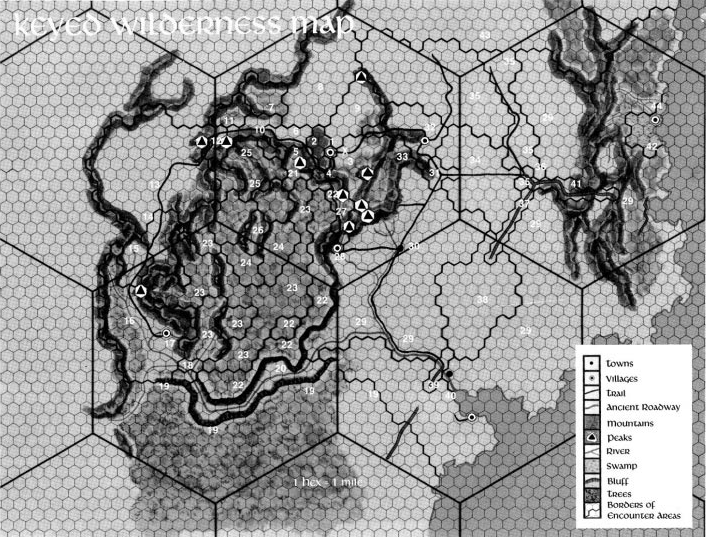
At first glance, this sure looks like a hexcrawl. It even features sub-hexes. (The larger, 20-mile hexes are made up of smaller, 1-mile hexes.)
But if you take a closer look, you’ll notice that the map is actually broken up into regions using thin black lines. It’s these regions which are actually keyed.
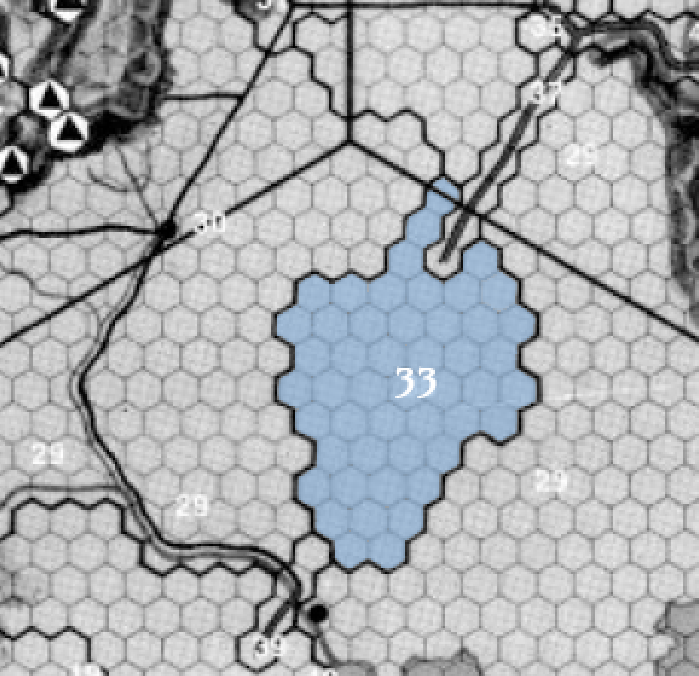
For example, the entirety of region 33 is keyed as the Kiri Valley:
The forest darkens and thickens beside an ancient trail. A cold, dry stillness hovers in the air, and the trees are knotted and bent. Everything seems to watch you.
An evil wizard died here long ago. Only his essence remains.
This technique allows Hickman’s key to cover the entire map without needing to key content to every individual hex.
If I was redoing this or taking inspiration from this, I would probably ditch the hexes entirely. Although they can be hypothetically helpful in counting out movement, they’re mostly getting in the way and badly impairing the legibility of the map.
(The 20-mile hexes do appear to correspond with a larger map printed in later modules, most notably DL11 Dragons of Glory, which we’ll discuss later. So there might be an argument for keeping those.)
JUST THE MAP, MA’AM
DL2 Dragons of Flame by Douglas Niles features an all-new, full color map of the same area which has also been expanded to the south:
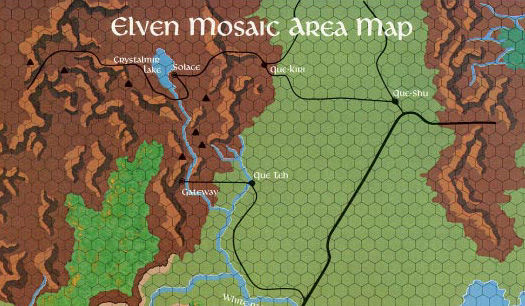
(This is only a sample of the large map, which extends down to a fortress called Pax Tharkas. Oddly the map lists the scale as 1 hex = 2 km, but the hexes align perfectly with the DL1 map.)
This map is an extreme version of many hexmaps that would follow: Rendered using hexes because that had become the expected norm for wilderness maps, but completely divorced from any key or structure that would make the hexmap relevant.
SURPRISE POINTCRAWL
DL3 Dragons of Hope, once again by Tracy Hickman, features a large, unkeyed poster map that unifies the previous hexmaps and then adds a big region to the south of Pax Tharkas (where DL3 takes place).
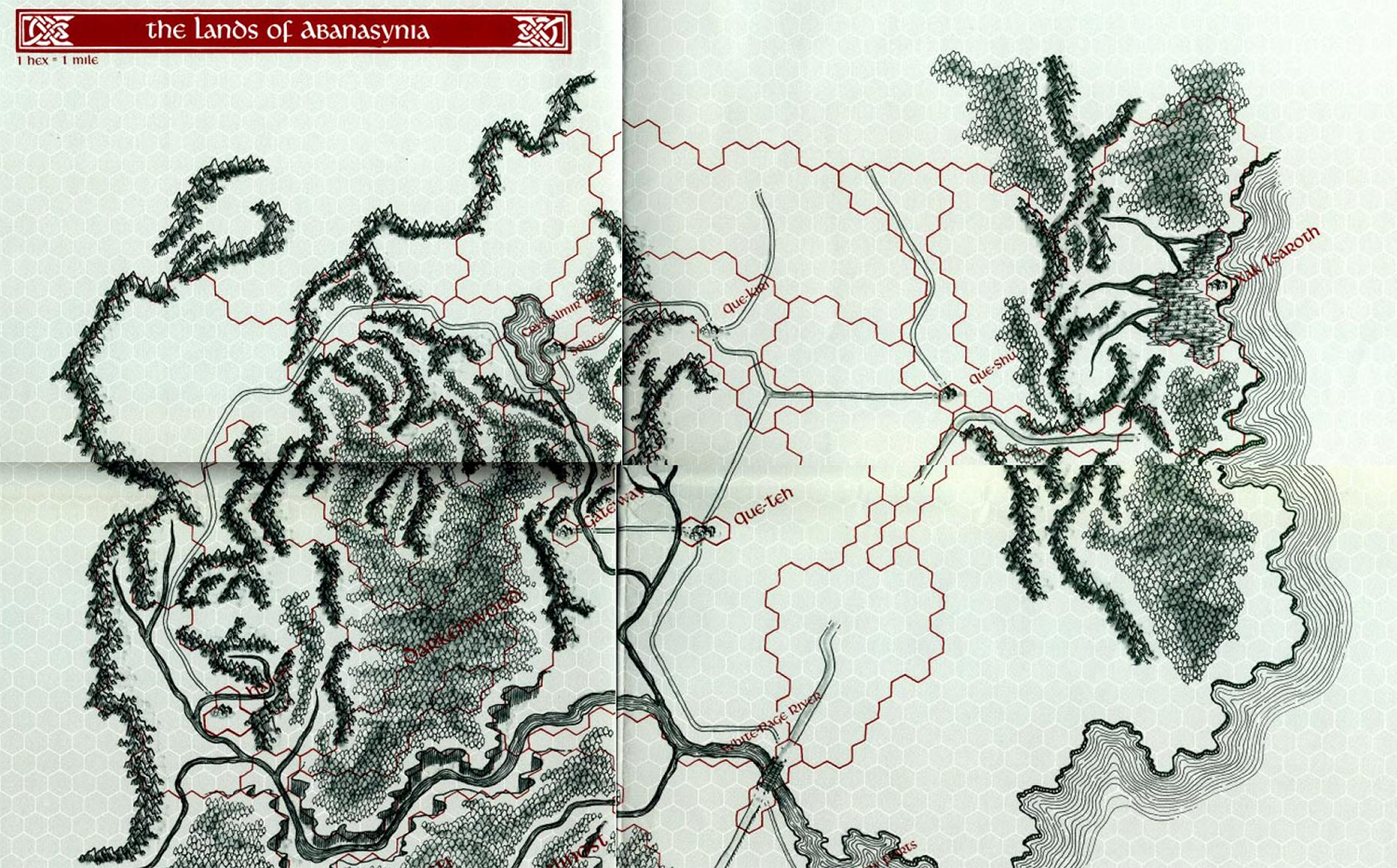
(Sorry for the poor image quality. Unfortunately, I only have a digital copy of this module and when Wizards scanned the PDF they completely botched it.)
This map seems pretty clearly intended for players, but it’s an odd one. Since DL2 didn’t feature regions, the middle of the map just… doesn’t have them.
The new DL3 regions were keyed on a separate inset map, which looked like this:
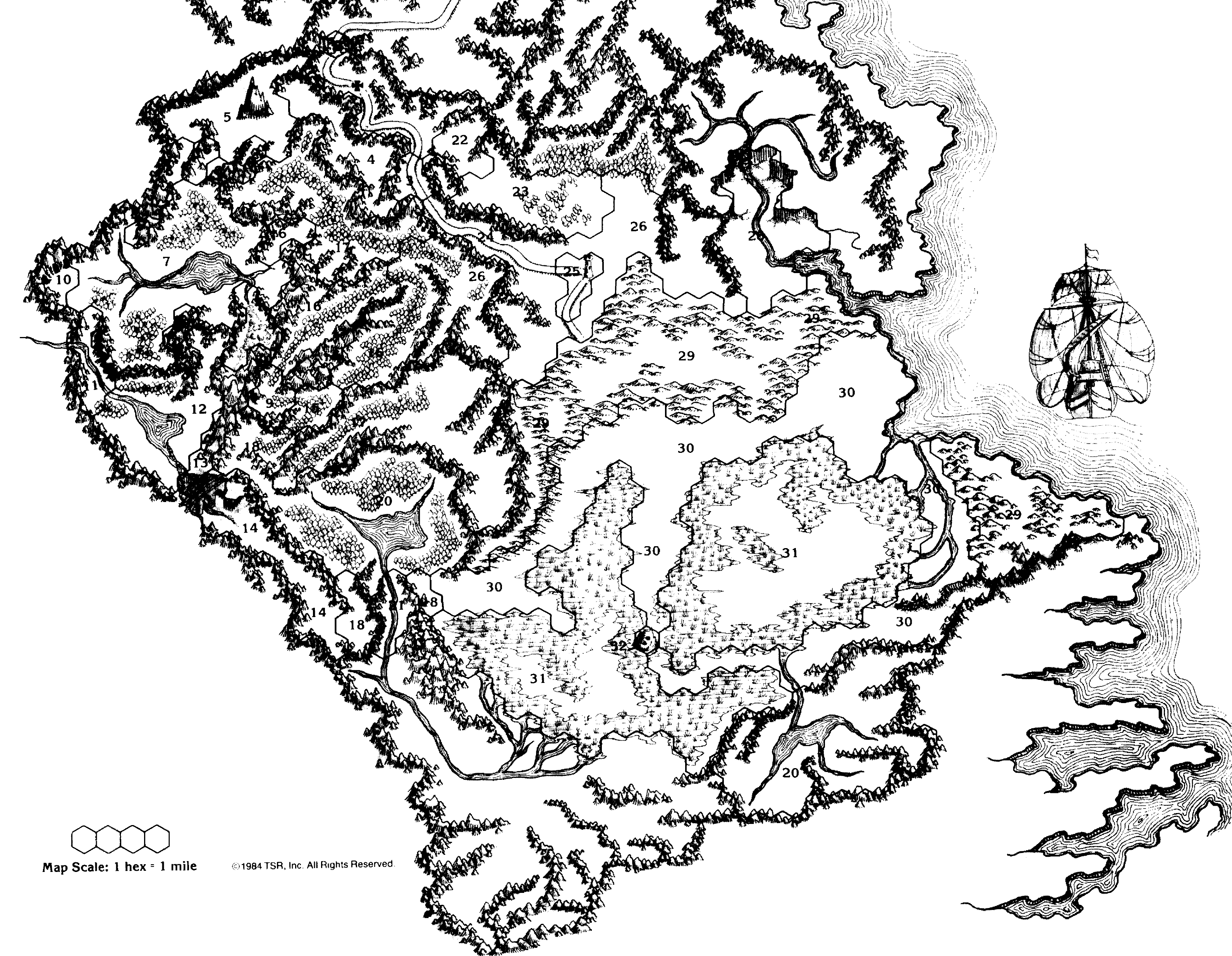
As you can see, the hex borders were eliminated. This makes the regions much easier to pick out, but obviously obfuscates the hexes.
The more crucial thing is that, although this looks like it’s meant to be run like the region-crawl in DL1, it’s actually keyed to work like what we would now call a pointcrawl. Here’s an example:
3. Southern Road
The broken remains of an ancient roadway glitter with windswept ice. Here and there, old monuments of stone jut from the frozen ground. Their surfaces are covered with snow-filled runes.
To the south, the way branches. The roadway, mostly covered in snow, turns to the east. To the west is a mountain pass that leaves the road. A set of footprints, short of step, follows the southwest route.
You’re not navigating by hex here. You’re choosing whether to follow the road or the pass and then you’re proceeding to the next keyed encounter along the path you’ve selected.
Go to Part 2

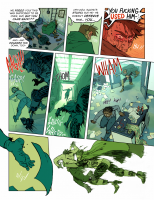

 miniature combat system and a full-fledged wargame. All of this was in service of created an epic fantasy adventure for D&D.
miniature combat system and a full-fledged wargame. All of this was in service of created an epic fantasy adventure for D&D.




